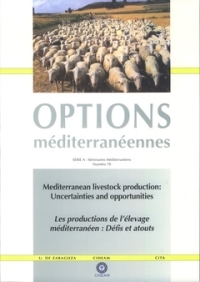| Article précédent | p. 301-306 | Article suivant |
Fat colour, a traceability parameter of grass feeding in lambs
Fifty Rasa Aragonesa light male lambs were submitted to one of the following four experimental treatments: Grazing (Gr), Grazing with supplement (Gr+S), Indoor (Ind) and Indoor-Grazing (Ind-Gr). The aim of this study was the use of fat colour to trace the different feeding systems, a specially grazing-fed vs indoors-fed. Muscle L. thoracis and perirenal fat colours in the CIELab space were measured with a spectrophotometer CM 2600d and the integral of the translated spectrum, as fat absolute value, was calculated. Data values were subjected to analysis of variance, a discriminant analysis, and a binary logistic regression. Meat from lambs reared under indoor systems showed a lighter colour and a sharp blooming 24 hours later. Fat from forage-fed lambs was lighter and more yellow. Discriminant analysis was able to classify them with 55% accuracy in the four treatments. However, it is confused when the classification must be done within feeding systems (Gr vs Gr+S and Ind vs Ind-Gr). A logistic regression classified 100% of lambs into the two feeding systems. Therefore, this regression can be used in on-line classification.
Cinquante agneaux mâles de poids léger et de race Rasa Aragonesa ont été soumis à un des quatre traitements suivants: Pâturage (Gr), Pâturage supplémenté (Gr+S), Stabulation (Ind), et Stabulation-Pâturage (Ind-Gr). L'objectif de ce travail a été l'utilisation de la couleur de la graisse pour tracer les différents systèmes d'engraissement: Pâturage vs Concentré. La couleur du muscle L. thoracis et de la graisse périrénale a été mesurée au CIELab espace avec un spectrophotomètre CM 2600d, et on a calculé la valeur de l'intégrale du spectre transporté comme étant la valeur absolue de la graisse. Les données ont été traitées avec les analyses de variance et discriminante, et la régression logistique binaire. La viande d'agneaux élevés en stabulation était plus claire et avait une nette couleur rouge 24 heures après. La graisse des agneaux soumis au pâturage était plus lumineuse et jaune. L'analyse discriminante avait la capacité de différencier avec 54% de réussite entre les quatre traitements. Cependant, la classification a été confuse dans les systèmes d'alimentation (Gr vs Gr+S et Ind vs Ind-Gr). Une régression logistique arrive à classifier 100% des animaux par systèmes d'alimentation. Par conséquent, cette régression peut être utilisée pour la classification on line.
- [ Afficher ]
- [ Télécharger ]
- [ Exporter la citation ]
Vous pouvez télécharger la citation au format :
- [ Imprimer ]
-
Mots-clés
CORPS GRAS ANIMAL, COULEUR, QUALITE, TRACABILITE, VIANDE D'AGNEAUCiter cet article
Ripoll G., Joy M., Muñoz F., Albertí P., Delfa R. Fat colour, a traceability parameter of grass feeding in lambs. In : Olaizola A. (ed.), Boutonnet J.P. (ed.), Bernués A. (ed.). Mediterranean livestock production: uncertainties and opportunities . Zaragoza : CIHEAM / CITA / CITA, 2008. p. 301-306. (Options Méditerranéennes : Série A. Séminaires Méditerranéens; n. 78). 2. Seminar of the Scientific-Professional Network on Mediterranean Livestock Farming (RME), 2006/05/18-20, Zaragoza, (Spain). http://om.ciheam.org/om/pdf/a78/00800281.pdf



